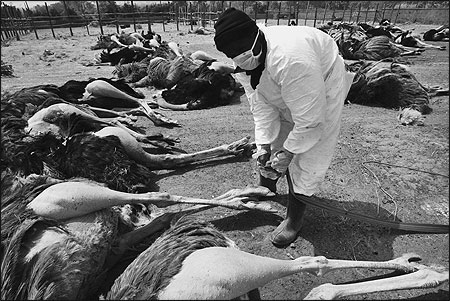
Reporters and editors discuss how they've covered disaster situations, including those in which people were infected by the H5N1 virus. And they talk about preparations they are making at their news organizations for coverage of pandemic flu.

Margie Mason, Asia Medical Writer, based in Hanoi, Vietnam, The Associated Press
On the ground, covering the unknown one step at a time.
As journalists, we are programmed to run toward danger. We do it daily, covering everything from war and natural disasters to political uprisings. We are fearless when it comes to chasing stories, driven to get there first and leave last. We evaluate the risks of each situation and make decisions about how to best report a story based on past experience and how much we know about the ongoing situation. It's never an easy call and, when covering a disease outbreak, it's like nothing else. Not only do reporters not know what they are up against, but they also are, potentially, putting all of their colleagues and their families at risk. So there is a lot to think about.
For nearly four years I have been learning how to react as a journalist to public health threats on the ground in Asia. From my experience dealing with SARS in March 2003 to the region's most recent bird flu outbreaks, I have always responded with caution whether it's wearing protective gear or opting to not go to a site. My editors and I frequently have lengthy discussions about how to best cover a story safely. And being careful doesn't mean losing the story. In fact, we often break stories from our desks — working the phones, tapping our sources, and keeping in close contact with those people who are closest to the action.
In mid-May I got a call one night while I was in Bangkok from a trusted source close to the bird flu story in Indonesia. He had heard that up to eight people were sick in North Sumatra, several of whom had already died from the H5N1 virus. No one else outside the family appeared to be ill, and no diseased poultry could be found in the village. We chatted for a few minutes about what this might mean. It was obviously the largest cluster ever reported. But was it spreading efficiently from human to human? He didn't think so, but it was way too early to know. For the next two weeks, I worked closely with our Jakarta bureau. Not knowing what to expect, we covered the story from a distance as more family members died.
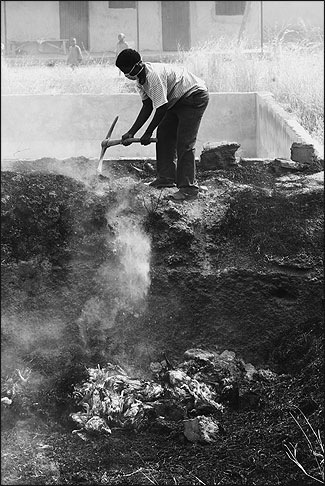
Reporting in a Sumatran Village
On May 23rd, the World Health Organization (WHO) announced that limited human-to-human transmission might have occurred between the relatives, but no other villagers were reporting flu-like symptoms. WHO also stressed that the virus had not mutated in any significant way that would indicate that a pandemic strain was emerging. After consulting numerous experts and sources, both from the animal and human health sectors about whether it was safe to go in, I flew to Sumatra and made my way to the mountainous village of Kubu Simbelang. I was one of just a few journalists who actually went to the village, and I wrote, probably, one of my most favorite bird flu stories, ever, about the villagers and how they were confused and angry about the way they were treated during the outbreak.
They believed that Tamiflu was poison. They thought that by giving blood samples it would lead to their deaths. They believed that being quarantined was basically the same thing as being taken to a slaughterhouse room, and they just didn't believe that bird flu existed. They thought that black magic was instead responsible for killing their neighbors and that ghosts were still roaming through the streets of the village, and that leads to a much deeper issue.
Every AP bureau in Asia is equipped with protective gear that's recommended by WHO. We all have boxes of gowns, masks, booties, goggles and, of course, Tamiflu, but when putting all of the gear on, not only is it extremely hot and uncomfortable when you are running around in Asia, but we looked like Martians. And we are going into villages where — in very remote areas, often — where people have not had a lot of contact with foreigners. In fact, I'm often told that I'm the first foreigner they have ever seen.
This is one of the challenges that we face. As journalists we risk alienating the people that we've traveled so far to talk to. The Sumatran village is a perfect example. The villagers had closed off the area at one point during the outbreak. There were fears that violence could erupt because it was an area of Indonesia that was not used to taking orders from the Javanese coming in from Jakarta. There were cultural, religious, regional sensitivities that flared. It was a big obstacle for WHO.
So how do you get the story in a village where people are terrified and potentially hostile? A moon suit is clearly not going to work. We knew that wearing the full gear would hinder our work, so we opted to go in without it, but we also had a plan. We stayed in the car much of the time when we got near the houses where the family members had lived. Instead of walking from one end of the village to the other, we drove to avoid as much contact with the ground as possible, even though the Food and Agriculture Organization of the United Nations (FAO) said there was no sign of H5N1 in any of the poultry in the village. We only spoke to a few people, and we did so outside and at a distance. Once back in the car, we sanitized our hands and the soles of our shoes. We also had a supply of Tamiflu with us, and if any flu-like symptoms had occurred, I would have phoned WHO and said, "Hey, help us! Send a doctor immediately!"
Another challenge involving the gear is to make sure that everyone understands its importance. In vast countries like Indonesia, AP has local stringers scattered across the archipelago that spans, literally, the width of the United States, and many of those stringers live in the same type of villages, with poultry running around, as the ones that we're trying to cover. So how do you convince someone to put on a mask and plastic booties to go out and grab quotes, color or take a few pictures? If they don't view the village as dangerous to begin with, it's a very hard sell. And sometimes they simply do not understand the risk, which is why it's up to supervisors, in our case bureau chiefs and photo editors, to make it clear. But again, it's difficult to create hard and fast rules when dealing with such a complicated story. Every situation in every country is different, and there has to be flexibility to deal with the story on a case-by-case basis.
One thing I do always is to insist that everyone feels comfortable going into the story. No one is ever ordered to go into the field and, in fact, there have been times when both reporters and photographers have turned down assignments, and that's okay. It's their choice. We make that very clear to them from the beginning, and there's no pressure, and if someone expresses any type of doubt, we basically tell them that they shouldn't go. And aside from this North Sumatra case, there are only a few times that I have gone into a bird flu village or chicken farm without some form of protection. I routinely wear the booties and mask when covering poultry vaccinations and mass slaughters and when visiting villages where someone has recently died.
Sometimes when I'm going out to these villages I'll be in the car with a photographer or a stringer or translator and they kind of joke around and are very reluctant to put on the gear and so I always ask them, "Do you have children?," and normally they say, "Yes," and we talk for a few minutes about that and they show me some pictures of their kids and I always say, "Well, when you go home tonight and you leave your clothes at the door, they probably don't pose that much of a danger to you, but what if your baby crawls over and starts playing with your boots and sticks her hands in her mouth?," and that usually does the trick. Usually it becomes crystal clear then that it is not worth taking the risk.
Whenever I need a reminder of what I'm potentially dealing with I can go back through some of my old notes and stories. I've interviewed both SARS and bird flu survivors days after they were discharged from the hospital, and I can tell you the H5N1 virus in its current form is very nasty — raging fevers, sweats, pain so intense that one man felt he was being hit by a hammer nonstop for days, headaches, coughing and the feeling that you're drowning because you can't breathe.
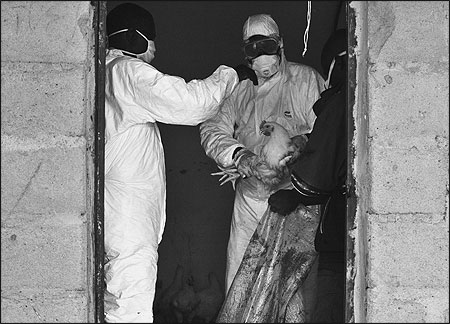
Covering Pandemic Flu
If a pandemic flu strain were to emerge and started spreading easily among people, our coverage would change. I'm always asking questions like, "What would you do? How would you work? Would you stay or would you leave?," and I think that these are extremely difficult questions to answer, and I don't have the answers. I think it would be a very fluid situation that none of us have ever dealt with on a worldwide scale.
Even for a disaster like Hurricane Katrina or the Asian tsunami, no one on the ground knew how to respond until they knew what they were up against and, even then, there were major problems, especially in the beginning. I don't think anybody in the news business, regardless of how much planning we do, will be following a step-by-step manual on how to work. I think that if it's the size of the 1918 Spanish flu pandemic, we will all be winging it to try to do our jobs. I can tell you that I won't be in the office, and I won't be out on the street interviewing people, and I won't be going into hospitals if that was to occur. I would likely be home, working the phones, and avoiding contact with as many people as possible and sleeping with my Tamiflu under my pillow at night.
In many ways SARS was a test run for us, as it was for WHO. We made mistakes and we learned from them and we were very lucky. We may get lucky again with bird flu, but eventually some nasty bug is going to emerge, and Asia is a likely candidate to be the host. Until then, we should use the experiences that we've gathered from covering SARS, bird flu, and other infectious diseases to generate dialogue and strategies. We should try to avoid the problems we encounter and take note of the barriers we've overcome on the ground. Most importantly, we need to realize that it's okay to step back and take a minute to think about what we're doing before we leap headfirst into this type of story. We're all smart, tough and very versatile people. We will make tough decisions and use our resourcefulness to find a way to tell the story. We always have, but ultimately it's up to us to inform the public and to record what would be a major moment in history.
Maggie Fox, Editor, Health and Science, Reuters
Covering bird flu on the spot and from half a world away.
This is a story like nothing else. I'm an old war reporter, in which you go in and you go out of a story. If pandemic flu strikes, it's going to be all around us, all the time. We're not going to be able to go in and out. A year ago my editor called me in and said, "I think pandemic flu is going to be the story of 2006, and we're going to put it together as a team, and we're going to figure out how to do it and do it right." So he made me global coordinator for pandemic flu and told me that we are going to have an editor in each region and train a network of people who will know how to deal with this and make sure we're covered.
At first we started daily conference calls, and they've become more sporadic now with these regional editors being in charge of the story and getting up to speed, covering conferences themselves and making sure that correspondents come to conferences, too, so that they're familiar with the difference between a virus and a bacteria or learning how if a person has respiratory symptoms that could mean a whole lot of different things. We want them to become familiar, too, with the whole background of SARS because, like any other news organizations, people cycle in and out of assignments and might not have any clue as to what the background is.
Reuters errs on the side of caution with its reporters' personal safety. During SARS, we didn't let anyone go into a SARS affected area. I'm not saying I necessarily agree with this decision, because we certainly send people to places where they are shot at, but I think it is because of the extra level of carrying infection to other people. We opted not to send people into H5N1 infected places where clusters have broken out or where there are infected people.
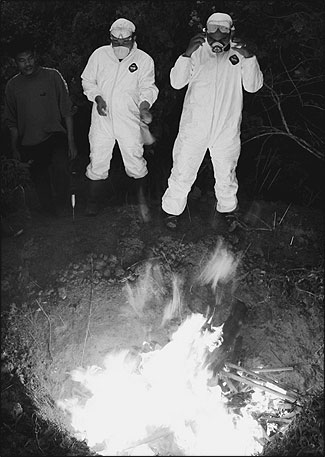
Developing Reporting Resources
We designated a whole team of reporters who were responsible for bird flu. We also set up an internal Web site, which was something that we'd never done before — a bird flu Web site where all the reporters and editors could go to. I've spent countless hours putting stuff on it — links to all of the WHO information, links to all the CDC information, links to lot of the stuff that Mike Osterholm has done. [See Osterholm's commen
ts in referred articles.] We've set up what we call boilerplate. If reporters have 15 or 20 minutes to write a story, it's a lot easier to have a block of information that they can put in, in which they haven't mixed up viruses and bacteria or pandemic flu and H5N1. And we update that. Every time WHO updates its numbers, we update our Web site. I've also got all of the contact numbers if we need to call experts quickly.
One of the things I try to bring home to our reporters is they should know now who their local state health officer, sheriff and local school principal are because they are really going to be important. They are going to be working in their home, and Reuters is going to go from being a big national news agency to being a local news agency. Wherever the pandemic flu erupts, they're going to be working from their homes, covering it like it's a local story. It's really ADDITIONAL AVIAN FLU RESOURCES
The Association of Health Care Journalists Web Site
– healthjournalism.orghard to get reporters to know a source before they need that source. We are in just-in-time supply distance, too. So my guy working the morning shift who doesn't know anything about bird flu wants me to give him my contact at the CDC so he can ask a bunch of very unprepared questions.
One problem is that people at Reuters don't use the bird flu Web site. I have done this, and nobody goes to the Web site. And this is something that we haven't touched on. People want information — the public wants information, journalists want information, everybody wants information — but you know who they want information from? They want information from the one person they know to get information from. Sometimes it's a local official, sometimes it is a person at WHO. In my office, it's me. They don't want to go to my Web site. They want me to tell them personally at the very moment that they need that particular piece of information. They would like me to personally alert them. I've had to turn off my internal instant messaging system because I get questions like, "Should I feed the birds in my backyard anymore?," and I get caught on a deadline trying to write, and I get these messages sent to me.
This story has made me realize exactly how sources feel. I've always been an observer. I've always been equipped to tell people, "I don't know shit about anything." And all of a sudden I am the resident expert in my company, which is a big company, and I'm supposed to tell them this stuff, and so I put together my risk communication plan and it's, "We've got to cover the story. We've got to make sure that we can cover the story, but on this — like no other story — we've got to cover ourselves, too." So I've been put in the unusual position of not only having to communicate to my fellow journalists but having to communicate to editors as well as corporate people.
After I became the bird flu editor, I went to my immediate editor and said, "Well, what I'm hearing at these flu conferences is that if you want people to have good measures to protect themselves, you have to make them make it a habit early on. You can't just wait until the pandemic hits and hand out a bunch of plans and apply them and give people masks and say, ÔProtect yourselves.' But if you, in fact, incorporate the use of these things in your day-to-day life, you will protect yourself, not only from pandemic, but from all of the cracks that're around every fault." So I got him to put plans in the newsroom, and I was very pleased about that. But then I said, "We'll also have to think about how we keep people working, keep people filing. If they come into the office, how do we protect them, and will we provide treatment? Will we get Tamiflu for people? Will we vaccinate?" He didn't even miss a beat, and said, "What about liability? What if we vaccinate people and they get sick and they sue us?"
This really does have to start now, so we're trying to figure out these things. One of the first things we had to work with was figuring out how we can file stories. We have external access to our system, but I found out to my horror at another meeting that it is all Internet based. We don't have any dedicated lines provided so if the Internet breaks down we're going to have a whole bunch of journalists that can't file. People are working on that.
We've done exercises in which everybody in a certain area worked from home that day on their laptop to see if our system would support it and so far it appears to. The biggest flaw is that a whole bunch of journalists don't know how to use their laptops. We aren't the most technical people out there, as you know. Have you noticed there are people who can crash their laptop no matter where they go? With a pandemic, are your technicians going to want to go out there and fix their laptops at their houses? I'm thinking not.
These are issues we never had to deal with before. With Katrina or Bosnia or Lebanon, we could fly in equipment or just send in correspondents who knew what they're doing. With this one we won't be able to do that. We've also set up editorial training exercises and, boy, do I have real respect for people who do training after this. Our training manager sent me her scenario on how it would unfold, and it was clear that she had no idea how the WHO works, no idea how the CDC works. Everybody thinks we're going to just call the CDC from 800,000 different places and there will be someone on the other end of the phone to answer our questions.
So what I tried to do, and failed miserably at, is to get some correspondents up to speed on this, and the Health and Human Services pandemic flu exercise was the perfect opportunity for this. "Okay, they're going to 50 states. You go cover Pandemic Influenza Day." Well, something happens on the cattle market that day, and they can't go because most of our correspondents cover commodities or equities or things like that. Or they go and they write the really obvious story. Or Michael Osterholm shows up and brings out his very articulate, well thought out comments, and that's all that gets reported. After this has been reported six times, it's not news anymore, but it is news to that correspondent because they haven't seen it before because they haven't read my beautiful Web site.
I'm just being really honest about the challenges that all of us face in trying to get people ready to take this on. My thought was that, by now, I would have a team of 16 journalists who would know a hell of a lot about bird flu having sat through many conferences like this. And I find out I'm still the only person at Reuters who knows anything about bird flu. That's not true because we have certainly got our correspondents in the field in Asia who are experts. And we've hired a health reporter in Hong Kong who knows a whole lot about this, and she has written some real good copy, and this would not have happened were it not for SARS and bird flu, and she'll be able to add a whole lot to our coverage. And some of our reporters in Africa are up to speed on this and certainly reporters in Europe have come up to speed. Here in the United States, it's a bit more of a challenge because it's not here yet. It hasn't provided a threat. It's not on the front pages of papers.
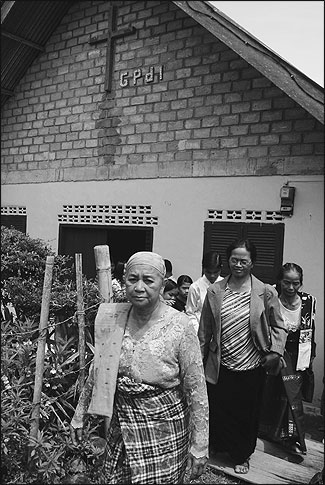
Christy Feig, Senior Medical Producer, CNN
The TV reporter's dilemma: When getting quotes over the phone won't do.
I tend to work on the frontlines, and television is a little bit different than print. I can't really get a story by picking up the phone and talking with someone. I've really got to have a camera there. With infectious disease that presents a whole other kind of complication.
About the time when the anthrax situation was happening, in the fall of 2001, CNN hired a team out of Britain to basically serve as our security advisors on all of these kinds of things. They go with us to war zones and to Katrina. They're medical advisors, security advisors, and they have a lot more information on this stuff than we do. They think about the "Don't set your camera down there." It's been very interesting what we've learned from them. And what we have decided so far for avian flu is that we've got Tamiflu stockpiled in certain places and HAZMAT suits in certain places. We train teams in certain areas. We have a doctor on call who will brief anybody before they go in — will give them an oral quiz before they go in. They are the first people the reporters talk to when they come out. And anyone can decide at any particular time that they don't want to go in.
To their credit, CNN will actually go to great lengths to get people out of any place that they don't want to be. We've had people sign up for hurricanes and all of a sudden decide they don't want to be in there, and we will find a way to extract them. But when push comes to shove and reporters get the call — we're journalists, and we want to be in the thick of it. And we often think about our safety last. We want the story, and when I say I'm not going to go in and the Fox network says, "I'm going in," I want to pass them on the road. It's just the way it is. We really can't help it.
This raises a lot of questions about what do you do to protect yourself as much as possible? You try not to go into the houses where someone has died and disinfect as soon as you can. But we're all in the same boat wondering how safe are we going to be when push comes to shove.
We've got some interesting things going on in preparing for this. If you've been in the CNN center in Atlanta, there is the huge food court and the Omni Hotel. It's a bubble, and they've actually got plans in place to take over the whole bubble with people that they can just keep inside the bubble for months on end if they need to, and that's where they can broadcast from. They and the broadcast studio in New York are the only ones that can carry the network by themselves. I don't want to be in the bubble — but it actually might work. We've also gotten a new technology room where we can feed video over the Internet, so there are some things they are trying with technology that are quite phenomenal.
In the discussion period that followed, reporters spoke about reporting on outbreaks of illness related to H5N1.
Alan Sipress, Staff Writer, The Washington Post: I must have been in two dozen villages where there were outbreaks and a dozen different clusters and in hospitals. And it's not that I'm reckless. But what we know about this strain right now is that it's really, really, really, really, really hard to catch this. It doesn't mean it's not impossible, it doesn't mean it's not going to change or mutate. When we started working the story in January 2004, we took a lot more safety precautions than we take now. We all take risk assessments as journalists. I have to say going into a village, where there is a cluster, is probably one of the safest things I do as a journalist. But maybe that isn't true. I go in and, when I get home, I immediately take a shower. I throw my clothes in the laundry and I wash off my shoes. And maybe that's a lot less than you do.
Maryn McKenna, Freelance Journalist and Kaiser Media Fellow: It's not just about the humans. All professionals make mistakes in estimating their risks, and the perfect example of this is that the bird flu outbreak in France that was spread from one farm to another by public health people who should have known what they were doing. That's how the outbreak expanded in France, so it's very possible for all of us to make mistakes, and it may not seem as though we are endangering each other or endangering other people or being a human vector.
Sipress: I should say if there is a farm where there is an outbreak, I won't go to the farm. I don't want to be spreading contamination, but if the site has already been cleaned and cleared, then it's a different situation.
McKenna: I have gone into disease outbreaks and covered the tsunami in Thailand. I was in New Orleans after Katrina, and I do not think there was ever a time in my career when I didn't go to the wall — and through the wall — for a story. And I'm really concerned that this part of the culture of journalism is going to ruin us, particularly with people who are less thoughtful, less trained, and less senior than the people in this room — people who have fewer resources than major news organizations. I do not know what the answer to this is. I wish there were more editors in the room.
Feig: That is a very valid point. All of us would do a lot to get a story, and it's the reason that we're journalists and not bankers. We will push ourselves farther than we should. We've studied this inside and out and, whenever something happens, it's going to be the closest journalist who gets it first and may not have that training, so I do share your concern.
Meg Haskell, Reporter, Bangor Daily News: We are probably the smallest newspaper in the room, and I'm probably the only dedicated health reporter in the state of Maine. We've been working on our pandemic plan for about a year, and it has been done in a catch-as-catch-can way. But one of the things we have identified is the need to work. Because we have such a small pool of media outlets covering the state, what we're trying to do is work out a mutual aid agreement with people in broadcast and other print outlets who are traditionally our competitors so that in the event of a pandemic, and we are all working with a 40 percent reduction of our workforce, we have the ability to work together to get the work done. That's important to us.



